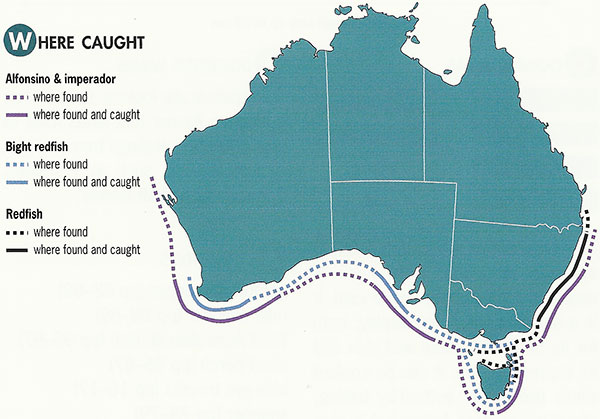Redfish are best suited to baking, shallow frying and grilling.
They are a major ingredient in fish cakes, quenelles, finfish balls, croquettes or gefilte fish as the flesh has good jelling characteristics, requiring very little binder.
Redfish are quite inexpensive, make excellent eating and are available as plate-size finfish or skinless fillets.
Catch limits
| Catch limit | Fishing Mortality* | Biomass** |
|---|---|---|
Catch Limit (Incidental) 30 tonnes For the 2025–26 Season | G;Not subject to overfishing | R;Overfished |
* Fishing mortality status relates to the level of fishing pressure on a stock – specifically, whether fishing mortality in the year being assessed is likely to result in the stock becoming overfished or prevent the stock from rebuilding from an overfished state. If fishing mortality exceeds either of these thresholds, a stock is considered to be subject to overfishing.
** Biomass status relates to how many fish there are – specifically, whether the biomass in the year being assessed is above the level at which the risk to the stock is considered to be unacceptable. The HSP defines this level as the limit reference point, below which the stock is considered to be overfished.
Scientific name: Centroberyx affinis
Family: Berycidae
Other names: Nannygai, golden snapper, red snapper, king snapper
Description: Redfish have a moderately short, compressed body and a spiny head. The upper parts of the head and body are red and the lower belly is silvery. The scales have red spots forming thin lines along the body. The tail is red and the other fins are pinkish. The tail fin is deeply forked. Redfish have large red eyes and an oblique mouth that extends back to the posterior margin of the eye.
Size (length and weight): Up to about 50 cm in length and 2 kg. Commonly found at 20‑30 cm in length and 0.2‑0.4 kg. Redfish are smaller than bight redfish (C. gerrardi).
Life span: Up to about 45 years.
Habitat: Redfish are endemic to the south-eastern waters of Australia. They inhabit reefs and muddy substrates on the continental shelf and slope. Bight redfish can be found down to depths of about 450 metres. Juveniles inhabit estuaries and shallow coastal waters. Adult redfish aggregate near the sea bed during the day, particularly at dawn and dusk, and disperse up into the water column at night to feed.
Prey: Small fish, crustaceans and molluscs.
Predators: Seals, seabirds and tunas.
Reproduction: Redfish reach reproductive maturity at 4‑7 years of age. Spawning occurs during late summer and autumn. Redfish are probably serial spawners. Fecundity is not well known but is thought to be low, with females potentially producing 20 000‑50 000 eggs per spawning season.
| Fishery found in | Gear used | Catch of species is targeted or incidental |
|---|---|---|
| Southern and Eastern Scalefish and Shark Fishery – Commonwealth Trawl Sector | Bottom trawl | Targeted |
The Commonwealth catch of redfish around the south east of Australia is managed by quota. Which means the catch of this fish by commercial fishers is restricted by weight.
Commercial fishermen are required to fill in records of their catches, during each fishing trip and when they land their catch in a port. This helps us keep records of how much is being caught.
AFMA decide on the amount that can be caught each year from expert advice and recommendations from fisheries managers, industry members, scientist and researchers.
Redfish are distributed along the Australian east coast from western Bass Strait to Moreton Bay, Queensland. The major catches of redfish come from the Commonwealth Trawl Sector of the Southern and Eastern Scalefish and Shark Fishery .
Most of the commercial catch is taken between 80-200 metres.

Redfish are caught using trawl nets.
Sometimes, bottom trawling can catch unwanted species of fish (not the type of fish the net was supposed to catch). This is known as bycatch and it is monitored by on-board fishery observers who assess the environmental impact of the trawling.
Although it is not physically possible to trawl on reef structures, significant long-term damage can occur if sensitive habitat areas like corals, sponges and seagrass beds are trawled. To ensure these sensitive habitat areas are protected from trawling, management arrangements such as area closures are extensively used.
To reduce the impacts of fishing on the environment, AFMA have a number of management arrangements and strategies in place including:
- minimum mesh sizes for otter trawls to reduce the catch of small and juvenile fish
- mitigation devices to reduce interactions with threatened endangered and protected species
- closing some areas to fishing to protect vulnerable species and habitats.
Gear
Want to know more?
This is just an overview of redfish, if you want to know more see the links below.
This fish is managed under the Southern and Eastern Scalefish and Shark Fishery.